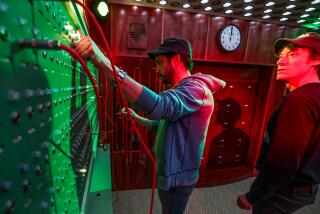Mind games: Using brain waves to play a video game
Lat Ware placed the NeuroSky headset on my 10-year-old son’s head and then began making the adjustments. The device detects brain waves, and then digitizes them. Ware, 28, had to make sure the headset was picking up the right waves before the real fun could begin.
Once everything was set, Ware provided some simple rules. Look at the computer screen where he had just launched the demo version of his work-in-progress video game called, “Throw Trucks With Your Mind!” Concentrate on one object, in this case a kind of futuristic tank sitting in a large chamber. The player has to elevate his level of calm and focus. And if that happens, then something extraordinary happens: The object will move.
Liam listened intently, and then, sitting with his hands in his lap, stared at the screen for a few seconds. The tank began to vibrate, then wobble, and then, it started rolling at a rapid clip toward the back of the chamber. Incredible.
“Yes,” Ware said. “You’re a natural!”
When my turn came, I was not so fortunate. My adult mind was racing. Liam was out of school, and his child care had fallen through, which is why he happened to end up at work with me that day. The train into the city was delayed. There were about 100 home fix-it projects on the to-do list. Concentrate. Concentrate. Concentrate.
Ware offered a few tips: Stare hard at a fixed point. Listen to the fan on the computer. Anything to still my cluttered mind, clear away the distractions. It was, basically, not unlike trying to meditate, actively trying to empty your mind. The big difference was that instead of trying to achieve oneness with the universe, I was trying to throw a tank.
Finally, the tank gave way and went flying across the room. Phew.
Ware had made the trek from his home in Mountain View, Calif., to my office in San Francisco a few days after my Los Angeles-based colleague, Sal Rodriguez, had written about the Kickstarter Project that Ware has launched to raise $40,000 to fund the full development of the game. As I write this, Ware has raised $32,094 from 336 backers, with five days left before the deadline.
Ware has almost a decade of video game development, both in college and professionally. He began work on this current game about 18 months ago on the side, and about six months ago felt confident enough to quit his job and work on it full time.
He turned to Kickstarter when he found himself stuck in a negative cycle with potential funders. Investors wanted to know he had some traction with players. But he couldn’t get a version built for players without some investment. The demo he showed me and Liam this week is a “proof of concept” that offered a handful of play environments.
After we both got comfortable, Ware pitted us against each other in a limited multiplayer environment. This will be the main goal of the initial version of the game: Squash the other players.
“In the focus testing I’ve done, people love crushing their friends with their minds,” he said.
As you play, you can switch between six different actions (i.e., throw, pull, lift) that you can affect on any object you find (you switch actions by typing the numbers 1 through 6. You use the mouse to change the direction you are facing). The powers don’t work on the other player. So you have to manipulate an object to attack and destroy the opponent.
“Dad, I’m going to squash you,” Liam declared.
And so, our digital battle of wills began. At times, we were focused on the same object, trying to bend it to our desired action, but stuck in a mental standoff. But mostly, I got the better of him, as it became more important to develop strategies about where to stand relative to the other player, and deciding which action to take.
But Liam caught on, too. At one point, he sneaked behind me, and then “pulled” a crate toward me. Unfortunately, he pulled too hard and killed both of us. Oh well.
Even as the game feeling kicked in, however, I still never shook the sense of wonder. I mean, moving stuff with your mind? It just doesn’t get any more sci fi than that. Yes, it’s just on a computer screen. But still... you’re moving stuff just by thinking about it!
This has been the dream of almost every child at least since the first “Star Wars” movie in 1977 introduced us to Jedi mind tricks. And not surprisingly, that was the dream that Ware also dreamed.
But his road to this moment involved another very personal journey. Ware has attention-deficit disorder. When he was a child, he was taken to neuro-feedback therapy, where a headset would be strapped to his head to monitor his brain waves in an attempt to help him regulate them better. In the process, Ware was amazed by the technology: You could capture brain waves and feed them into the computer.
In more recent years, companies like NeuroSky of San Jose developed lower-cost, easy-to-use headsets. The version Ware uses costs just $80. If someone pledges $125 to the project, they get a copy of the game and a headset.
The deadline for funding the project is midnight West Coast time on Wednesday.
Assuming the money comes through, Ware is going to hire four other people to help finish development of the game. He’s promising a version to backers in a year, but he’s optimistic it could be done in six months.
Ware is also hopeful that he’ll eventually be able to demonstrate that the game has some therapeutic benefits, though any such claims will no doubt carry some controversy until some studies back them up. Still, Ware argues that typically in neuro therapy, a patient, as he was years ago, is placed in a quiet room with few distractions, given a headset, and told to focus on brain waves.
Fine, but it’s not the real world, where distractions fly at you all the time.
“It’s like learning self-defense without sparring,” he said. “Teaching you to be calm and focused when people are throwing cars or when bots are shooting you is much better training.”
But first things first. He has to finish the game, and then, assuming it gets enough traction, he has a long list of additional features he wants to add.
“I have grandiose plans,” he said.
More to Read
Inside the business of entertainment
The Wide Shot brings you news, analysis and insights on everything from streaming wars to production — and what it all means for the future.
You may occasionally receive promotional content from the Los Angeles Times.











